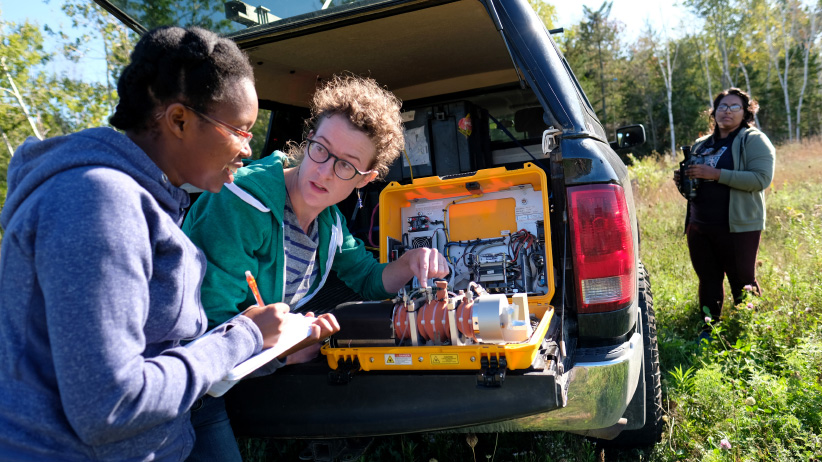Science meets Society: Studying Climate Change at St. Francis Xavier
A new program promises to teach both the science and social impact of climate change
StFX FluxLab students and technicians work with Earth Sciences professor, Dave Risk, developing state-of-the-art sensors that detect CO2 and methane emissions in a variety of environments, including oil and gas fields. Their goal is to help reduce Greenhouse Gas emissions. From left to right, Susan Gichuki PhD, Alex Tevlin PhD, and Nadia Tarakki MSc candidate. (StFX)
Share
[widgets_on_pages id=”university_guide_global_forever_header”]
[widgets_on_pages id=”university_guide_2018_intro_header”]

When Samantha Gray started a master’s degree in climate change at the University of Waterloo this past year, she realized her knowledge had gaps in it. With an undergraduate earth sciences degree from St. Francis Xavier in Antigonish, N.S., she had a solid background in the sciences, but she lacked a foundation in the economic, policy and legal sides of her chosen field. “It’s important to understand the science, but you have to know how to apply that science in lawmaking and policy framework,” she says. “Looking back, I would have wanted a more interdisciplinary approach to my undergrad program.”
Starting in fall 2018, StFX students will have access to exactly that. The school’s new bachelor of arts and science in climate and environment program focuses on both the scientific and social sides of the impact humans have on the world. “There are lots of jobs across all industries where the grads are required to have skills that are interdisciplinary,” says Dave Risk, chair of the university’s earth sciences program and one of the professors who helped create the program. “There’s a change in the global job market because of the major green shift.”
The four-year program will include a mandatory core curriculum with an evenly weighted mix of science and social courses, such as introduction to the climate system, introduction to science-based policy, and climate change and people, which will be taught in collaboration with the university’s Coady International Institute. Courses in chemistry, mathematics, economics, philosophy and sociology round out the program.
Students will be given the option to specialize either in climate, a concentration that focuses on the earth’s atmosphere and climate system, or environment, which offers classes that look at resource management, chemical contaminants and earth processes.
A variety of courses offer Indigenous content and points of view on environmental and climate issues, and more are in the works. “Indigenous peoples’ close relationship to the natural environment has provided them with both a framework and specific knowledge about the environment and climate change that can further enrich students’ understanding of our surrounding environment,” says Risk.
The program draws on the expertise of faculty from multiple university departments to give students a comprehensive understanding of how people affect the earth, and vice versa. “We need the science to inform policy and we need the economics to understand the science. The nature of the issue is interdisciplinary,” says Patrick Withey, associate professor of economics and another member of the program’s founding committee. “If we need to understand why sea levels will rise, we have to understand how much they will rise and also who will be affected by it.” In his natural resource economics class, for example, students examine the effect on the Canadian and global economies of industries like fossil fuels, water resources and forestry. A scientific understanding of the way those industries impact the environment helps students tackle issues such as biodiversity conservation and sustainability.
The interdisciplinary approach has been working well at StFX, says Risk, and students are asking for more integrated learning opportunities. “We looked at our other interdisciplinary programs and saw that they were generating fantastic job outcomes,” says Risk. “Students want options. They want depth, but they know the world is a more complex and nuanced place than it was before and they’re not going to have just one career.”
The program offers hands-on learning opportunities to complement classroom learning. For example, students in Risk’s field methods class will camp out in a cabin on Cape Breton Island to conduct studies on water, air and vegetation. Fourth-year students take courses that allow them to apply what they’ve learned in the classroom to real-world issues and scenarios. “Students propose projects that will suggest community solutions and take on some consulting with partner organizations,” says Risk. And there’s an option to take on a 12- or 16-month co-op placement.
Graduating students can expect to find work in a wide range of industries, from government policy to retail and manufacturing. “These days you see that companies across all sectors are hiring people who have a responsibility for sustainability,” says Risk. “All big companies need people who are thinking about being green.”
Samantha Gray hopes to find a career in government, helping to change the way society handles climate change. As a proponent of the interdisciplinary method, she welcomes the new approach at her alma mater. “A program in arts and science will prepare students for the real world,” she says. “When it comes to climate change and the environment, I don’t think it’s possible to do just one without the other.”
MORE ABOUT ST. FRANCIS XAVIER:
- How to look at the severed forearm of a saint
- One night at St. Francis Xavier, Canada’s top party school
- Campus life at St. Francis Xavier University
- Can’t miss campus shows (Oct. 24th to 30th)
- Preppy boys and laid-back girls in Antigonish
- That’s the spirit
- Many more students, less funding
- And another university prez without a Ph.D.
Bottom: [widgets_on_pages id=”university_guide_2018_outro_footer”]